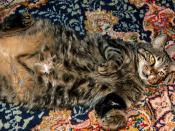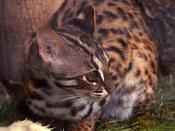The felid coat pattern evolution proposes that the primitive pattern is one of relatively large spots that break down into smaller spots (flecks) and rosettes while at the same time leading to various striped patterns as sidelines. The primitive pattern appears to be flecks, and it is from this type that nearly all other types have developed. Latest analyses identified eight major felid patterns by using DNA sequence from aDNA, xDNA, yDNA, and mtDNA gene segments. Eight Felidae lineages are strongly supported by bootstrap analyses and Bayesian posterior probabilities (BPP) for the nDNA data, by rare shared derived indels in the domestic cat lineage, by transposed nuclear mtDNA sequences in the domestic cat and Panthera lineages, by 11 to 65 diagnostic sites for individual lineages, and by amino acid data analyses of 14 genes. The radiation of recent felids initiated with the divergence of the Panthera lineage leading to the clouded leopard and the "great roaring cats" of the Panthera genus.
The Panthera lineage division led to the bay cat lineage, followed by the divergences of the caracal lineage and of the ocelot lineage, which were supported by bootstrap support (BS). A more modern clade (lynx, puma, leopard cat, and domestic lineage groups) is supported by the nDNA BS. The divergence of the lynx lineage gave the puma lineage its appearance. Domestic cat and leopard cat lineages were the two most recently derived groups. Support for enclosure of the pallas cat within the leopard cat lineage included a single insertion/deletion (APP+1).
The earliest traces of the Felinae are attributed to late Miocene (~ 9 Ma) using a Bayesian approach with 16 fossil calibrations. The late Pliocene-Pleistocene felids divergences happened during the age of low sea levels before the beginning of Pleistocene glacial oscillations. The modern felids in Asia with the...


